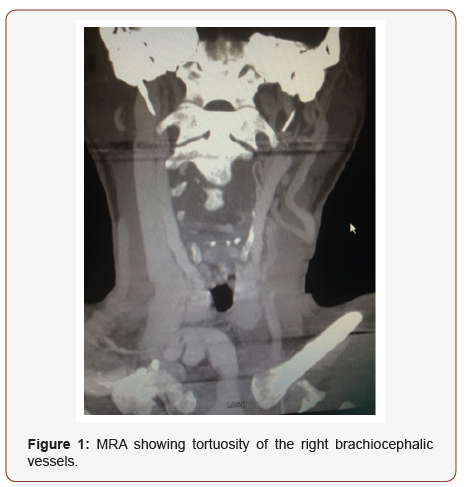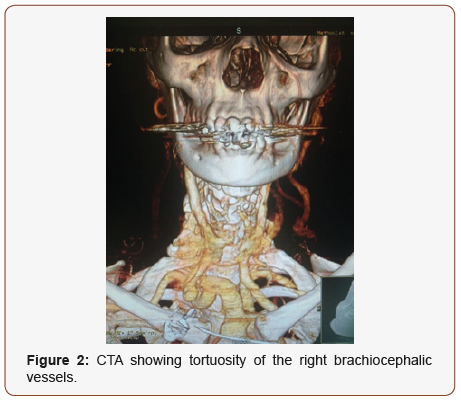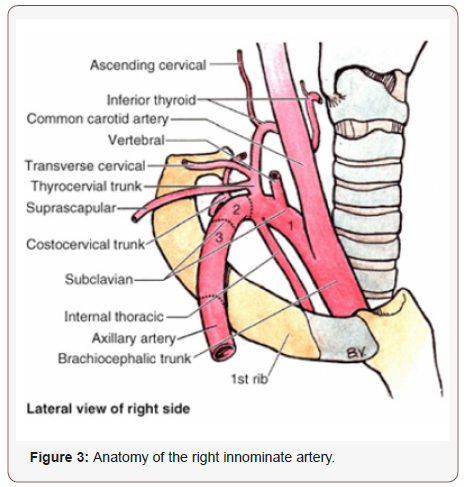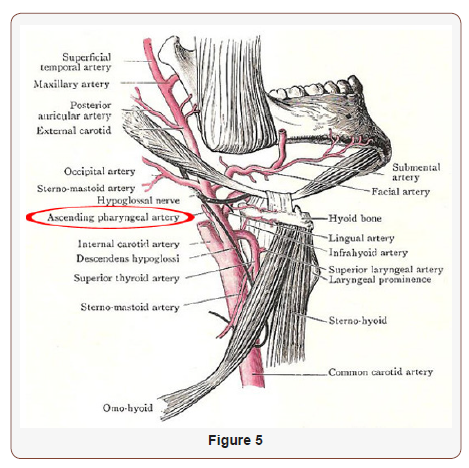 Case Report
Case Report
Lingual Spasms Associated with Internal Carotid Artery Tortuosity
Mervat Wahba, Associate Professor of Neurology, USA.
Received Date: February 28, 2019; Published Date: March 12, 2019
Abstract
When a mass is visible in the anterior aspect of the neck of a patient, differential diagnoses of masses as tumors, lymph nodes or vascular lesions are contemplated. When the lesion is pulsating, on the right side of the anterior neck, a tortuous innominate artery simulating a mass is likely. We describe a case of innominate and right carotid artery tortuosity that was detected while treating the patient for a hypertensive urgency.
Case Report
This is a 53-year-old lady presented to the hospital for treatment of hypertensive emergency. Her blood pressure was 220/114 upon arrival. Neurology was consulted for evaluation of episodic tongue spasms with left deviation of the tongue that started an hour before arrival to the hospital. There was no loss or alteration of consciousness, no epileptic activity. There was no chief complaint of weakness, visual or speech abnormalities [1]. A right supraclavicular pulsating mass was noted. There were bilateral carotid bruits. The neurological exam was normal. MRI of the head was negative for acute stroke. Magnetic resonance angiography and computerized CT angiography showed an ectatic right brachiocephalic vessels with tortuosity of the right extracranial internal carotid artery [2] (Figures 1&2).


Hypoglossal nerve vascular supply
The nerve is supplied by arteries that arise from the ascending pharyngeal artery as it exits from the hypoglossal canal, the occipital artery as the nerve passes under its branch to the sternomastoid muscle, direct branches from the external carotid artery, and branches from the ascending pharyngeal artery just near the bifurcation of the common carotid artery [4]. Within and close to the tongue, the nerve is supplied by branches from the lingual artery (Figures 3 to 5).



A possible mechanism explaining the hemi lingual spasm
The hypoglossal nerve leaves the intracranial space by the hypoglossal canal passing into the carotid trigonum through the gap between the internal jugular vein and the ICA. At this level, hypoglossal palsy is most frequently caused by benign and malignant tumors such as schwannoma, chordoma, metastasis, nasopharyngeal carcinoma and lymphoma [5]. Tortuosities of the extracranial ICA may be asymptomatic or mostly present clinically with transient ischemic attacks and extremely rarely with lesions of the caudal cranial nerves.
The tortuosity of the extracranial ICA may have caused stretch of the hypoglossal nerve leading to focal excitation and hyperactivity of the hypoglossal nerve. This mechanism may be similar to that of trigeminal or glossopharyngeal neuralgias. The blood pressure was managed per protocol. The lingual spasms did not recur. Stroke prevention education was offered [6]. The patient continues to be neurologically intact. There was no recurrence of abnormal movements [7,8].
Conclusion
Tortuosity of the innominate and carotid artery is uncommon, is more likely to accompany chronic hypertension that causes loss of elasticity of the vascular wall. Genetic factors contributing to this finding are unclear. Search for other vascular anomalies in the patient by performing vascular studies, secondary stroke prevention is crucial in managing this condition. Caution should be exercised in approaching these patients should emergent tracheostomy is required. Tortuous arteries may not need surgical treatment as long as no focal stenosis or aneurysmal dilatations accompany the condition.
Acknowledgemnet
None
Conflict of Interest
No conflict of interest.
References
- De Ridder D, Alessi G, Lemmerling M, Fransen H, DeWaele L (2002) Hemi lingual spasm: a new neurosurgical entity? J Neurosurg 97(1): 205-207.
- Lees AJ, Blau JN, Schon F (1986) Paroxysmal hemiglossal twisting. Lancet 2(8510): 812-813.
- Mauersberger W (1974) Extreme tortuosity of the internal carotid artery associated with disturbances of cerebral blood supply and paresis of the hypoglossal nerve (in German). Neurochirurgia 17: 91-95.
- Scotti G, Melancon D, Olivier A (1978) Hypoglossal paralysis due to compression by a tortuous internal carotid artery in the neck. Neuroradiology 14(5): 263-265.
- Heckmann JG, Tomandl B, Huk W, Neundörfer B (2000) Dissection of extracranial arteries supplying the brain (in German). Dtsch Med Wochenschr 125(44): 1333-1336.
- Moller AR (1999) Vascular compression of cranial nerves. II. Pathophysiology. Neurol Res 21: 439-443.
- Naraghi R, Hastreiter P, Tomandl B, Bonk A, Huk W, et al. (2004) Threedimensional visualization of neurovascular relationships in the posterior fossa: technique and clinical application. J Neurosurg 100: 1025-1035.
- Leipzig TJ, Dohrmann GJ (1986) The tortuous or kinked carotid artery: pathogenesis and clinical considerations. A historical review. Surg Neurol 25: 478-486.
-
Genc Struga, Mervat Wahba. Lingual Spasms Associated with Internal Carotid Artery Tortuosity. Arch Neurol & Neurosci. 2(5): 2019. ANN.MS.ID.000550.
-
Lingual Spasms, Carotid Artery Tortuosity, Neurology, Tumors, Anterior, Vascular, Lymph nodes, Diagnoses, Hypertensive urgency, Supraclavicular pulsating, Hypoglossal canal, Nerve, Schwannoma, Chordoma, Metastasis, Nasopharyngeal carcinoma, Lymphoma, Neuralgias, Aneurysmal dilatations.
-

This work is licensed under a Creative Commons Attribution-NonCommercial 4.0 International License.






